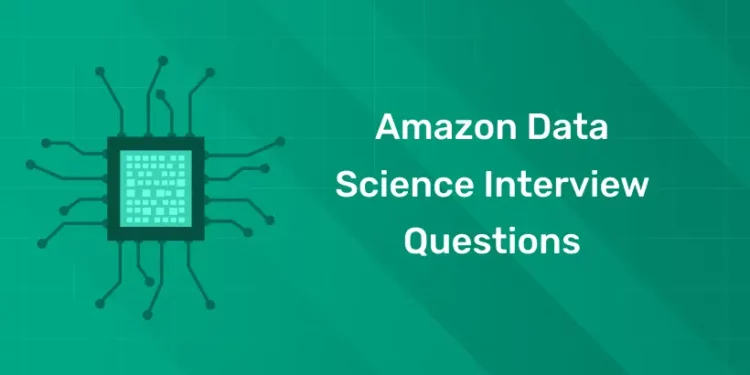Table of Contents
Why Join Amazon as a Scientist?
1: Which of the following algorithms is most suitable for classification tasks?
Joining Amazon as a Scientist offers unique opportunities that appeal to professionals seeking cutting-edge challenges, impactful projects, and the ability to contribute to a globally influential organization. Here are the key reasons to consider a scientist role at Amazon in detail:
1. Access to Vast Data and Advanced Infrastructure
Amazon operates at an unprecedented scale, managing enormous amounts of data generated from customer interactions, sales, logistics, and more. As a scientist at Amazon, you gain access to some of the most comprehensive and diverse datasets in the world, enabling research and experimentation that can have real-world impacts.
Amazon’s world-class cloud infrastructure, through AWS (Amazon Web Services), also allows scientists to process, analyze, and model data efficiently using state-of-the-art computing resources, making large-scale projects more feasible.
2. Impactful Work with Global Reach
Scientists at Amazon work on problems that directly affect millions of customers and thousands of businesses around the world. Whether you’re involved in natural language processing (NLP) for Alexa, recommendation algorithms for Amazon.com, or improving operational logistics, the research you conduct can have a significant and visible impact on customer experiences, operations, and even entire industries.
For example:
- Machine learning scientists develop models that improve product recommendations, dynamic pricing, and inventory management.
- Data scientists may analyze customer behavior to enhance personalized shopping experiences.
- Research scientists could contribute to next-gen technologies like AI-driven warehouse automation.
3. Focus on Innovation and Experimentation
Amazon fosters a culture of innovation and experimentation. The company encourages scientists to explore novel ideas and test them in real-world settings. Teams like Amazon Research and AI Labs are dedicated to pushing the boundaries in fields like artificial intelligence, machine learning, robotics, quantum computing, and cloud computing.
Amazon is known for its “Working Backward” approach, where innovations are guided by customer needs and goals. This methodology allows scientists to drive innovation that delivers measurable results and customer satisfaction.
4. Interdisciplinary Collaboration
At Amazon, scientists frequently collaborate with engineers, business leaders, and product managers across different departments. This interdisciplinary approach ensures that research translates into practical solutions and products. For example:
- A machine learning scientist may work closely with software developers to implement algorithms that power search engines or fulfillment networks.
- Data scientists might partner with economists and business analysts to forecast trends and make data-driven decisions.
These collaborations foster a cross-functional environment that strengthens both scientific inquiry and business outcomes.
5. Career Growth and Learning Opportunities
Amazon is committed to professional development, offering scientists the chance to attend conferences, publish research, and continue education. Working at Amazon also provides scientists with the freedom to explore various roles and functions within the company, enabling career flexibility and advancement.
The company’s Leadership Principles emphasize a culture of ownership and learning, encouraging scientists to take the lead on innovative projects and continuously refine their skills.
6. Global Challenges and Societal Impact
Amazon’s scale provides scientists with the chance to work on global challenges, including:
- Improving sustainability and reducing the environmental impact of logistics.
- Enhancing healthcare through its health ventures like Amazon Care and PillPack.
- Empowering small businesses and startups through its marketplace and AWS services.
Solving such large-scale problems means that scientists at Amazon can drive positive changes that affect not just the company’s bottom line but also broader societal issues.
7. Competitive Compensation and Benefits
Amazon offers competitive salaries and benefits packages, including stock options, performance-based bonuses, and health insurance. The total compensation is often higher than in academia or smaller tech firms. Amazon also provides a work environment where scientific contributions are highly valued, which can lead to rewarding experiences both intellectually and financially.
8. Work-Life Flexibility
While Amazon is known for a high-paced environment, the company also supports flexible working arrangements, including remote work options and flexible hours, depending on the team and role. This flexibility allows scientists to maintain a healthy work-life balance while continuing to pursue ambitious research goals.
Enhance your data science skills with us! Join our free demo today!
Amazon Data Science Interview Preparation Tips
Preparing for a Data Science interview at Amazon requires a strong foundation in a variety of technical, analytical, and problem-solving skills. Here are some key tips to help you prepare:
1. Understand Amazon Leadership Principles
Amazon places a strong emphasis on their leadership principles during interviews. Be prepared to demonstrate how your experiences align with these principles (e.g., customer obsession, ownership, frugality, etc.) during both technical and behavioral rounds.
2. Brush Up on Core Data Science Concepts
Amazon interviews often cover the fundamental aspects of data science, so make sure you have a solid grasp on:
- Statistics: Hypothesis testing, A/B testing, probability distributions, p-values, confidence intervals, etc.
- Machine Learning: Supervised and unsupervised learning algorithms, model evaluation (ROC, AUC, Precision, Recall), overfitting/underfitting, and feature selection.
- Data Wrangling: Data cleaning, transformation, and analysis.
- Programming: Proficiency in Python or R, including libraries like pandas, NumPy, SciPy, and scikit-learn.
3. Algorithms and Data Structures
Amazon interviews, particularly for technical roles like data science, often involve coding questions related to algorithms and data structures. Focus on:
- Arrays, linked lists, hashmaps, trees, and graphs.
- Common algorithms such as sorting, searching, and dynamic programming.
- LeetCode and HackerRank are great resources to practice coding questions, especially in Python.
4. SQL and Database Queries
Strong SQL skills are critical for a data scientist at Amazon. Be prepared to:
- Write complex SQL queries for data extraction and analysis.
- Solve problems involving joins, subqueries, window functions, and aggregation.
- Practice optimizing queries for performance.
5. Big Data and Cloud Technologies
Amazon often deals with huge datasets. You should have an understanding of:
- Big Data technologies such as Hadoop, Spark, and data pipelines.
- Cloud platforms, particularly AWS (Amazon Web Services), since Amazon operates extensively on AWS. Familiarity with tools like S3, Redshift, and EMR is beneficial.
6. Case Study/ Business Problem Solving
Amazon data science interviews often include a case study or a business problem to assess your problem-solving skills and understanding of business impact. Be prepared to:
- Analyze large datasets.
- Define key metrics and KPIs.
- Develop a solution and explain your reasoning clearly.
- Make data-driven recommendations for optimizing or improving the business process.
7. Behavioral Interview Questions
Behavioral interviews are a major component at Amazon. Use the STAR method (Situation, Task, Action, Result) to structure your answers. Prepare examples from your experience that demonstrate:
- Leadership (e.g., handling a challenging situation, taking ownership).
- Customer obsession (e.g., how you improved a process or product based on customer feedback).
- Dealing with ambiguity (e.g., making decisions with incomplete data).
8. Communication Skills
As a data scientist, you’ll need to explain complex data and insights to stakeholders who may not be familiar with the technical details. Practice:
- Communicating your findings clearly and concisely.
- Explaining technical concepts in a way that non-technical audiences can understand.
9. Mock Interviews and Practice Problems
- Use platforms like InterviewBit, Glassdoor, or Pramp for mock interviews.
- Participate in coding challenges and take sample data science tests.
- Study commonly asked Amazon data science questions and interview experiences on forums like LeetCode Discuss or Glassdoor.
10. Amazon-Specific Scenarios
Familiarize yourself with specific data challenges Amazon might face in areas like e-commerce, logistics, AWS, etc. For example, you may be asked to optimize a recommendation engine or predict inventory needs for a large-scale operation.
Enhance your data science skills with us! Join our free demo today!
Top Amazon Data Scientist Interview Questions and Answers
Here are the Top 25 technical Amazon Data Scientist interview questions along with suggested answers:
1. What is the difference between supervised and unsupervised learning?
Answer: Supervised learning uses labeled data to predict outcomes, whereas unsupervised learning works with unlabeled data to identify patterns or groupings.
2. Explain the bias-variance tradeoff.
Answer: The bias-variance tradeoff refers to the balance between model complexity and accuracy. High bias can cause underfitting, while high variance can cause overfitting. A good model minimizes both.
3. How do you handle missing data in a dataset?
Answer: Common techniques include removing missing values, imputing using statistical methods (mean, median, mode), or using algorithms like k-NN imputation or model-based approaches to estimate missing values.
4. Explain the difference between L1 and L2 regularization.
Answer: L1 regularization (Lasso) adds the absolute value of weights as a penalty to the loss function, promoting sparsity. L2 regularization (Ridge) adds the squared value of weights, encouraging small, non-zero weights but not sparsity.
5. What are precision, recall, and F1-score?
Answer:
Precision: True Positives / (True Positives + False Positives).
Recall: True Positives / (True Positives + False Negatives).
F1-Score: Harmonic mean of precision and recall.
6. How would you approach a classification problem with imbalanced data?
Answer: Techniques include resampling (oversampling the minority class, undersampling the majority class), using synthetic data (SMOTE), changing class weights in the loss function, or using anomaly detection models.
7. Explain cross-validation and why it’s important.
Answer: Cross-validation, especially k-fold, splits the data into k subsets to train and validate the model multiple times. It ensures that the model performs consistently across different samples, preventing overfitting.
8. What is multicollinearity and how do you handle it?
Answer: Multicollinearity occurs when independent variables are highly correlated, making it difficult to isolate the effect of each predictor. Solutions include removing correlated features, using PCA, or regularization techniques.
9. How would you evaluate the performance of a clustering algorithm?
Answer: Common metrics include Silhouette Score, Dunn Index, and Davies-Bouldin Index. Visual inspection using techniques like t-SNE or PCA is also useful for understanding cluster separation.
10. Explain the Central Limit Theorem (CLT).
Answer: The CLT states that the sampling distribution of the sample mean approaches a normal distribution as the sample size increases, regardless of the population’s distribution, provided the samples are independent and identically distributed.
11. What is A/B testing? How do you interpret the results?
Answer: A/B testing compares two groups (A: control, B: treatment) by randomly assigning participants to each. Results are interpreted using statistical significance tests, such as the t-test, to determine if the difference in means is significant.
12. How does a decision tree algorithm work?
Answer: Decision trees split data based on feature values that result in the greatest information gain or least Gini impurity. Each split divides the dataset into two parts, which are further divided until a stopping criterion is met.
13. What is overfitting, and how do you prevent it?
Answer: Overfitting occurs when a model learns the noise in the training data instead of the underlying pattern. Preventative measures include cross-validation, regularization (L1, L2), simplifying the model, or pruning decision trees.
14. Explain the difference between bagging and boosting.
Answer: Bagging reduces variance by training multiple models in parallel on random subsets of data and averaging the predictions (e.g., Random Forest). Boosting builds models sequentially, where each new model corrects errors from the previous one (e.g., AdaBoost, Gradient Boosting).
15. What is the curse of dimensionality?
Answer: As the number of features increases, the data becomes sparse, making it difficult for models to generalize. Dimensionality reduction techniques like PCA or feature selection help mitigate this issue.
16. How does a random forest algorithm work?
Answer: Random Forest builds multiple decision trees on random subsets of the data and features, then averages their predictions (for regression) or takes the majority vote (for classification) to improve accuracy and reduce overfitting.
17. What is a p-value and how is it interpreted?
Answer: A p-value represents the probability that the observed data could have occurred by chance under the null hypothesis. A small p-value (typically < 0.05) indicates strong evidence against the null hypothesis.
18. How do you interpret a confusion matrix?
Answer: A confusion matrix displays True Positives, True Negatives, False Positives, and False Negatives, helping to calculate metrics like accuracy, precision, recall, and F1-score to evaluate classification performance.
19. Explain Principal Component Analysis (PCA).
Answer: PCA is a dimensionality reduction technique that transforms correlated variables into a smaller number of uncorrelated components, preserving as much variance as possible while reducing dimensionality.
20. What is gradient descent and how does it work?
Answer: Gradient descent is an optimization algorithm used to minimize the cost function by iteratively updating the model parameters in the opposite direction of the gradient of the cost function until convergence.
21. What is a confusion matrix and what does it contain?
Answer: A confusion matrix is a performance measurement tool for classification models that shows the actual vs. predicted values. It contains True Positives, True Negatives, False Positives, and False Negatives.
22. Explain the difference between classification and regression.
Answer: Classification is used when the target variable is categorical (e.g., spam/not spam), while regression is used when the target variable is continuous (e.g., predicting house prices).
23. What are Type I and Type II errors?
Answer: Type I error occurs when a true null hypothesis is rejected (false positive), and Type II error occurs when a false null hypothesis is not rejected (false negative).
24. Explain the K-means clustering algorithm.
Answer: K-means is an unsupervised learning algorithm that partitions data into k clusters by minimizing the distance between data points and their corresponding cluster centroids, which are iteratively updated.
25. What is time series forecasting, and which models would you use?
Answer: Time series forecasting predicts future values based on past observations. Common models include ARIMA (AutoRegressive Integrated Moving Average), Exponential Smoothing, and LSTM (Long Short-Term Memory) for neural networks.
Enhance your data science skills with us! Join our free demo today!
Amazon Data Scientist Interview Questions for Freshers
For freshers preparing for an Amazon Data Scientist interview, here are some common questions and answers. These cover key areas like statistics, machine learning, data manipulation, and programming.
1. What is overfitting, and how can you avoid it?
Answer:
- Overfitting occurs when a model learns the training data too well, including noise, leading to poor performance on new, unseen data.
- To avoid overfitting:
- Use cross-validation.
- Implement regularization techniques (L1, L2).
- Prune decision trees or use early stopping in iterative algorithms.
- Increase training data or simplify the model.
- Use dropout for neural networks.
2. Explain the difference between supervised and unsupervised learning.
Answer:
- Supervised learning: The model is trained on labeled data (input-output pairs). Examples include classification and regression tasks.
- Unsupervised learning: The model finds patterns in data without labels. Examples include clustering and association rule mining.
3. What is a confusion matrix?
Answer:
- A confusion matrix is a table used to evaluate the performance of a classification model.
- True Positives (TP): Correctly predicted positive cases.
- True Negatives (TN): Correctly predicted negative cases.
- False Positives (FP): Incorrectly predicted positive cases (Type I error).
- False Negatives (FN): Incorrectly predicted negative cases (Type II error).
- It helps derive metrics like accuracy, precision, recall, and F1-score.
4. What is A/B testing, and how is it used in data science?
Answer:
- A/B testing is a statistical method used to compare two versions of a variable (A and B) to determine which one performs better.
- In data science, it’s commonly used to optimize product features, marketing strategies, and website designs by splitting traffic or users and measuring outcomes (e.g., conversion rates).
5. How would you handle missing data in a dataset?
Answer:
- Several ways to handle missing data:
- Remove rows or columns with missing values (if the amount of data missing is small).
- Impute missing values using methods like mean, median, mode, or using advanced techniques like K-Nearest Neighbors (KNN) or regression imputation.
- Use algorithms that can handle missing data, such as certain tree-based models.
6. What is multicollinearity, and how do you detect it?
Answer:
- Multicollinearity occurs when two or more independent variables in a regression model are highly correlated, which can distort the coefficient estimates.
- To detect multicollinearity:
- Use Variance Inflation Factor (VIF). VIF values above 10 may indicate multicollinearity.
- Check the correlation matrix for high correlations between variables.
7. Explain the concept of p-value in hypothesis testing.
Answer:
- The p-value is the probability of observing results as extreme as those measured, under the assumption that the null hypothesis is true.
- A low p-value (typically < 0.05) indicates strong evidence against the null hypothesis, suggesting the result is statistically significant.
8. What is gradient descent, and how does it work?
Answer:
- Gradient Descent is an optimization algorithm used to minimize a cost function by iteratively moving towards the minimum.
- It works by computing the gradient (partial derivatives) of the cost function concerning model parameters and updating the parameters in the direction that reduces the cost function.
9. How do you evaluate the performance of a regression model?
Answer:
- Common metrics to evaluate regression models include:
- Mean Absolute Error (MAE): Measures the average magnitude of errors.
- Mean Squared Error (MSE): Penalizes larger errors more than MAE.
- R-squared (R²): Indicates the proportion of variance in the dependent variable that is predictable from the independent variables.
- Root Mean Squared Error (RMSE): The square root of MSE, offering a similar interpretation to standard deviation.
10. What is the difference between bagging and boosting?
Answer:
- Bagging (Bootstrap Aggregating): Involves training multiple models in parallel on different subsets of the data (with replacement) and averaging their predictions. Example: Random Forest.
- Boosting: Sequentially builds models where each new model focuses on correcting the errors of the previous one. It typically reduces bias and variance. Example: XGBoost, AdaBoost.
11. Can you explain what cross-validation is and why it is important?
Answer:
- Cross-validation is a technique used to evaluate a model’s generalization ability by partitioning data into training and testing sets multiple times.
- The most common method is k-fold cross-validation, where the data is split into k subsets, and the model is trained k times, each time using a different fold as the test set and the remaining as the training set.
- It helps prevent overfitting and gives a better estimate of model performance on unseen data.
12. What is the Central Limit Theorem (CLT) and why is it important?
Answer:
- The Central Limit Theorem states that the sampling distribution of the sample mean will approximate a normal distribution as the sample size becomes large, regardless of the population’s distribution.
- It is important because it allows us to make inferences about population parameters even when the population distribution is not normal, provided we have a large enough sample size.
13. Describe a time-series problem and how you would solve it.
Answer:
- A time-series problem involves predicting future values based on historical data points, like stock prices, weather data, or sales.
- To solve a time-series problem:
- Plot the data to understand trends, seasonality, and stationarity.
- Use models like ARIMA (Auto-Regressive Integrated Moving Average), Exponential Smoothing, or machine learning models like LSTM (Long Short-Term Memory) networks for deep learning-based approaches.
14. Explain feature scaling and why it is important in machine learning.
Answer:
- Feature scaling involves standardizing or normalizing the range of independent variables.
- It is important because many machine learning algorithms (like gradient descent-based methods and distance-based models like KNN and SVM) perform better when features are on a similar scale.
- Two common methods are Min-Max Scaling and Standardization (Z-score scaling).
15. What are precision and recall? How do they differ?
Answer:
- Precision: The ratio of true positives to the total predicted positives. It measures how many selected items are relevant.
- Recall: The ratio of true positives to the total actual positives. It measures how many relevant items are selected.
- Difference: Precision focuses on the quality of positive predictions, while recall focuses on the completeness of positive predictions.
Enhance your data science skills with us! Join our free demo today!









